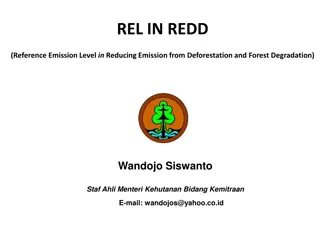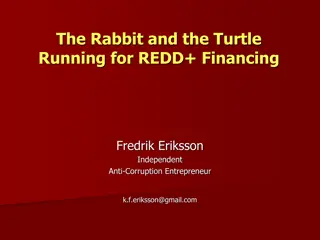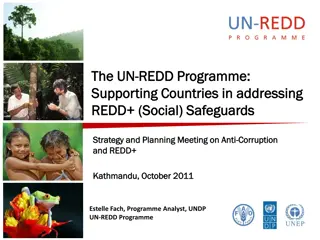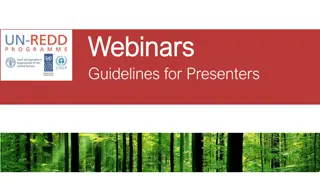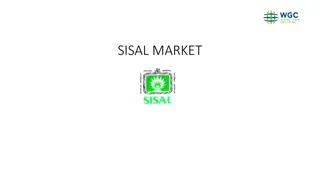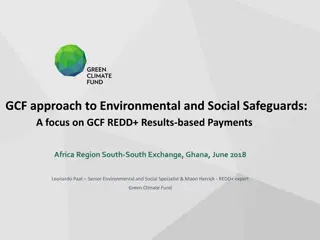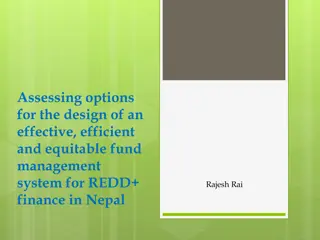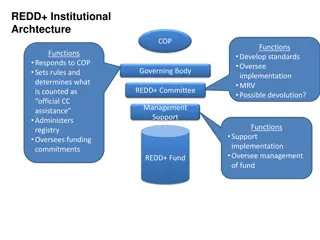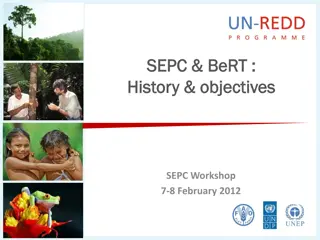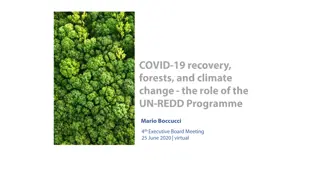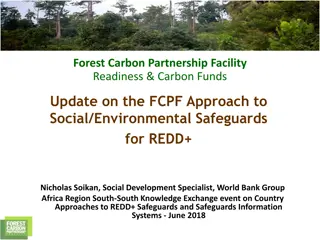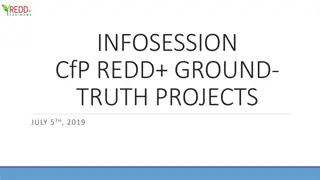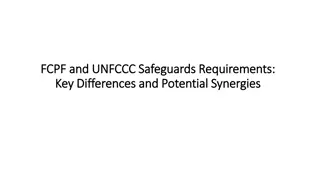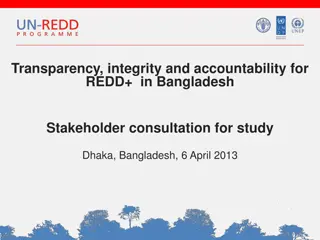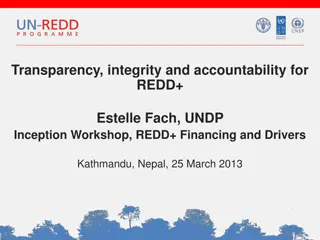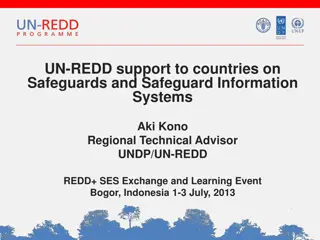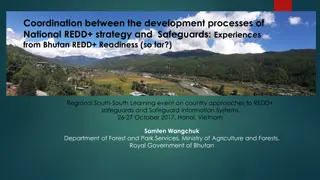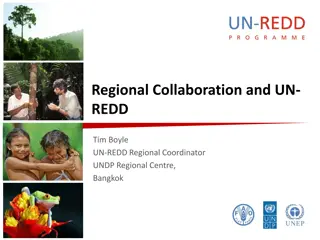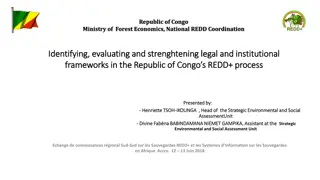Navigating the Evolution of REDD+ Program in Brazil
The journey of REDD+ in Brazil has been marked by ups and downs as reflected in the program's contested ascent. From its promising inception to struggles with implementation, REDD+ faces challenges amidst changing stakeholder perceptions and evolving environmental policies.
Download Presentation

Please find below an Image/Link to download the presentation.
The content on the website is provided AS IS for your information and personal use only. It may not be sold, licensed, or shared on other websites without obtaining consent from the author. Download presentation by click this link. If you encounter any issues during the download, it is possible that the publisher has removed the file from their server.
E N D
Presentation Transcript
BECCS: OPTIONS FOR BRAZIL REDD ALERT: THE CONTESTED ASCENT OF THE PROGRAMME ON REDUCING EMISSIONS FROM DEFORESTATION IN BRAZIL Prof. Raoni Raj o, PhD Laboratory of Environmental Services Management (LAGESA) - Coordinator Engineering School Federal University of Minas Gerais (UFMG) Engenharia de Produ o
Research Problem REDD+: PES aiming at at Reducing Emissions from Deforestation and Forest Degradation; Research aims: understand the process of institutionalization of REDD+ by uncovering the logics of the different actors involved; Methodology: interpretive policy analysis based on interviews with key stakeholders (diplomats, policy-makers, scientists, NGOs, farmers, local population). ?
Short History of REDD+ 2006: Stern Review Report (UK Government) Curbing deforestation is a highly cost-effective way to reduce emissions [ ] this could get underway very quickly . 2007-9: During a research about deforestation control policies, REDD was cited by policy-makers and members from NGOs as the solution: Add economic value to the standing forest vs inefficient command & control policies; Economic efficient way to tackle climate change. 2008: Amazon Fund is created and Norway pledges to donate $ 1 billion by 2015 => policy-makers report that this money could be use to kick-start REDD; 2010: REDD seems eminent We are going to need lots of consultants in order to be able to implement REDD. It is coming soon and it will be big (Official from a UN body); 2010: REDD is tropical forests best hope (The Economist).
Short History of REDD+ 2011-2012: REDD struggles to gain life within the COPs: COP-17, Durban, 2011: REDD gains a multisource model (in contrast to the large- scale, CDM-like cap & trade approach it was hoped for); COP-18: REDD negotiations halt over technical and financial disagreements; 2012: Supporters change position CIFOR recognizes that implementation is harder than anticipated; REDD has turned yellow (IPCC scientist); REDD is not the salvation [ ] it will never be something involving large amounts of money (Key Brazilian policy-maker) Key NGO start to look for alternatives to diverge attention (and funds): ex. LERD
Short History of REDD+ 2011-2012: REDD pilot projects show problems: Four years after its creation, Amazon Fund has been able to distribute only 9% of the money it received from donors (Norway shows discontentment); Cases involving Carbon Cowboys emerge; NGOs and local groups present REDD+ more as a curse than as a bless.
Towards an Institutional Understanding What has happened? How REDD turned from the solution to not the salvation ? In other words, why is the institutionalization processes of REDD apparently halting? Neo-Institutional theory in organizations: Scott (1995)
Towards an Institutional Understanding Social action (including institutionalization) guided by competing institutional logics (Raj o & Hayes, 2009); Institutionalization start out as vague ideas and become more concrete via the establishment of norms, rules and technologies (Hasselbladh & Kallinikos, 2000); Institutionalization is the contested ascent from abstract to concrete (Blackler & Regan, 2006).
Institutional Logics of REDD+ Market + Conservation/Carbon (M+C): REDD+ as a strictly economic mechanism: change behavior by providing profitable sustainable alternatives Aim to find effective (measurable CO2 reductions) and efficient (low cost) solution to tackle climate change Governance + Development (G+D): REDD+ as a way to induce sustainable development via state interventions Aim to improve the livelihood of the local population and increase economic output In an ideal world M+C and G+D operate in synergy
Institutional Logics of REDD+ In practice there are increasing tensions between these institutional logics as REDD+ is translated into concrete rules: Market+Carbon Governance+Development Commoditization of nature (local population), loss of sovereignty and uncertain outcome (MRE) Need to protect local populations and foster environmental justice (NGOs, MMA) Cap and Trade Efficient way to reduce CO2 emissions (Traders, Research NGO) Safeguards Increase transaction cost and renders REDD+ unfeasible (Traders) Resource allocation Based on measurable CO2 reductions (Traders, Research NGO) Fund governmental actions (MMA), Foster local economic development (SAE, Local NGO)
Conclusion Early consensus concerning REDD in Brazil related to the initial vagueness of the concept: Supporters from different sides had their own interpretation/logic of how REDD would fit their agenda; Vagueness contributed to (the illusion) of consensus. As REDD started it ascent into concreteness the different between institutional logics started to emerge: Became evident the incommensurability of different logics; The future success of REDD s institutionalization hinge two possible paths: Flexibility: a boundary object that it may mobilize a specific local uses while maintaining an superficial common use and identity: Problems with scope, overlaps and lack of central control. Expansive learning: untie the deadlock through self-understanding, criticism and change: Challenge basic assumptions (and logics) of the actors involved
Thank you for your attention. Raoni Raj o rajao@ufmg.br
Short History of REDD+ Year (Location) 1997 (Kyoto) Meeting Name Key Points COP3 Adoption of Kyoto Protocol Article 3: Provision related to forest- related sinks 2001 (Marrakech) COP7 Marrakech Accords Adoption of rules for application of LULUCF activities 2005 (Montreal) COP11 Papua New Guinea and Costa Rica proposed the idea of issuing carbon credits from REDD and avoiding deforestation in developing countries. It was decided that the related discussions should be concluded within two years. Subsequently, the SBSTA (Subsidiary Body for Scientific and Technological Advice) and workshops coordinated by SBSTA started their reviews. REDD proposed for negotiations 2007 (Bali) COP13 The Bali Road Map was adopted. Decided to consider Policy approaches and positive incentives on issues relating to reducing emissions fromdeforestation and forest degradation in developing countries; and the role of conservation, sustainable management of forests and enhancement of forest carbon stocks in developing countries. The adoption of the Bali Road Map resulted in the broader concept of REDD+, which also includes consideration of the roles of forest conservation, sustainable forest management, and increasing forest area carbon stocks. Development from REDD to REDD+ 2009 (Copenhagen) COP15 Member states took note of the following statement, which was included in the Copenhagen Accord: We recognize the crucial role of reducing emission from deforestation and forest degradation and the need to enhance removals of greenhouse gas emission by forests and agree on the need to provide positive incentives to such actions through the immediate establishment of a mechanism including REDD-plus, to enable the mobilization of financial resources from developed countries. COP16 Following from the Copenhagen Accord, the Cancun Agreements were adopted, which included respect by developing countries for indigenous populations, and also development of working milestones to determine monitoring methods through the efforts of SBSTA. Reconfirmation of the importance of REDD+ 2010 (Cancun) Proposal on specific work to implement REDD+


![Halal_Chicken_from_Brazil-_Ensuring_Quality_and_Authenticity[1]](/thumb/86918/halal-chicken-from-brazil-ensuring-quality-and-authenticity-1.jpg)
